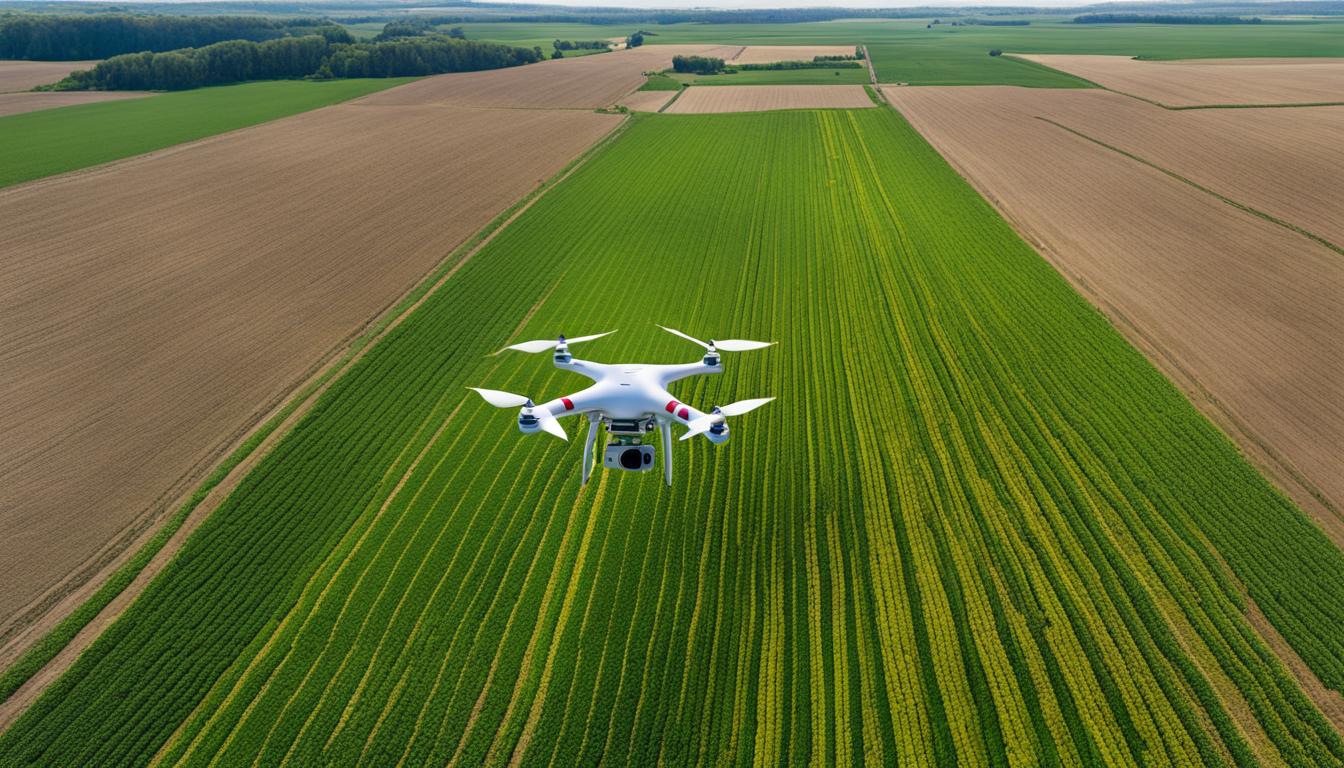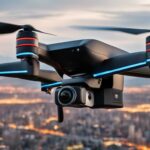Drones in agriculture have revolutionized the way farmers monitor and manage their crops and livestock. With advanced drone technology, farmers can now gather high-resolution imagery and detailed data, allowing for more precise and efficient farming practices. The use of drones in agriculture has seen significant growth, and it’s easy to see why.
By utilizing drones, farmers can easily monitor crop and livestock conditions, survey land topography, and collect soil and water samples. This real-time data helps farmers make informed decisions about irrigation, fertilization, pest control, and overall farm management. The benefits of using drones in agriculture are vast, and their applications are only expanding.
Key Takeaways: Benefits of Using Drones in Agriculture
- Drones in agriculture provide high-resolution imagery and detailed data gathering.
- They enable farmers to monitor crop and livestock conditions, survey land topography, and collect soil and water samples.
- Drones save time, increase efficiency, and improve overall productivity in farming.
- They optimize crop health and quality by providing accurate information on growth, health, and soil moisture.
- Using drones in agriculture helps reduce costs, save resources, and promote environmental sustainability.
Increase Efficiency and Productivity with Drone Technology
Drones in agriculture offer a wide range of benefits, including the ability to increase efficiency and productivity on farms. By utilizing drone technology, farmers can enhance their crop monitoring processes, save time, and reap the rewards of precision agriculture. Let’s explore how agricultural drones can optimize farming operations and lead to better results.
One of the key advantages of using drones in agriculture is the enhanced crop monitoring capabilities they provide. Drones equipped with high-resolution cameras and sensors can capture detailed images and data, allowing farmers to closely monitor the health and development of their crops. This real-time information enables farmers to quickly identify potential issues, such as nutrient deficiencies or pest infestations, and take prompt action to address them. By detecting problems early on, farmers can prevent crop damage and maximize yield.
In addition to improved crop monitoring, agricultural drones also save valuable time for farmers. Traditionally, crop inspections and data collection required manual labor and time-consuming processes. With drones, farmers can cover large areas of land quickly and efficiently, collecting data and images in a fraction of the time it would take using traditional methods. This time-saving benefit not only increases productivity but also allows farmers to allocate their resources more effectively, focusing on other critical tasks.
Precision agriculture is another significant advantage of utilizing drones in farming. With the data gathered by drones, farmers can analyze the information to make data-driven decisions regarding irrigation, fertilization, and pest control. The precise data provided by drones helps farmers optimize their resource allocation, ensuring that water, fertilizers, and pesticides are applied in the right quantities and at the right locations. By practicing precision agriculture, farmers can reduce waste, increase efficiency, and ultimately improve their overall farm productivity.
| Benefits of Drone Technology in Agriculture |
|---|
| Enhanced crop monitoring capabilities |
| Time-saving benefits |
| Precision agriculture optimization |
“Drones in agriculture offer enhanced crop monitoring capabilities, saving valuable time for farmers, and optimizing precision agriculture practices.”
Improved crop monitoring with drones
Drones provide farmers with a bird’s-eye view of their crops, enabling them to spot potential issues quickly and take immediate action. With the ability to capture high-resolution images and data, drones help farmers monitor crop health, identify areas of concern, and make informed decisions to improve overall productivity. By maximizing efficiency and utilizing the latest technological advancements, drones are revolutionizing agriculture and paving the way for a more sustainable and prosperous future.
- Increased efficiency with drones in agriculture
- Improved productivity with agricultural drones
- Enhanced crop monitoring with drones
- Time-saving benefits of agricultural drones
- Precision agriculture using drones
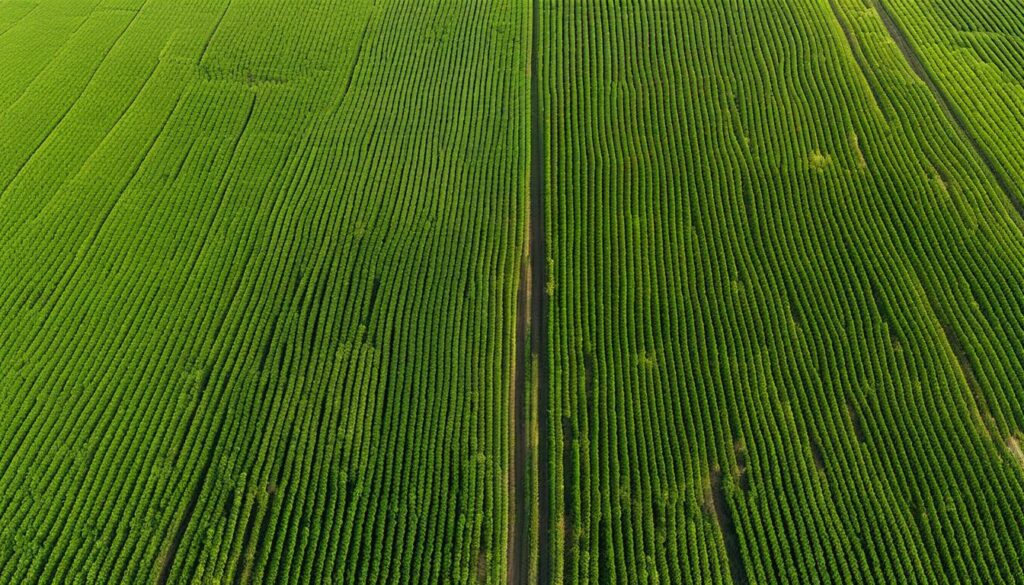
As the agriculture industry continues to evolve, the use of drones offers significant advantages for farmers. With increased efficiency, improved crop monitoring, and the time-saving benefits they provide, agricultural drones are transforming the way farming is done. By embracing drone technology, farmers can enhance their productivity, optimize resource allocation, and ultimately achieve better crop yields.
Optimize Crop Health and Quality with Drones
Drones equipped with advanced sensor technology play a crucial role in optimizing crop health and quality. By providing detailed and accurate information on crop growth, health, and soil moisture, drones enable farmers to make informed decisions about irrigation, fertilization, and pest control. With their aerial crop analysis capabilities, drones can quickly survey large areas of land and provide valuable insights into crop health and potential issues.
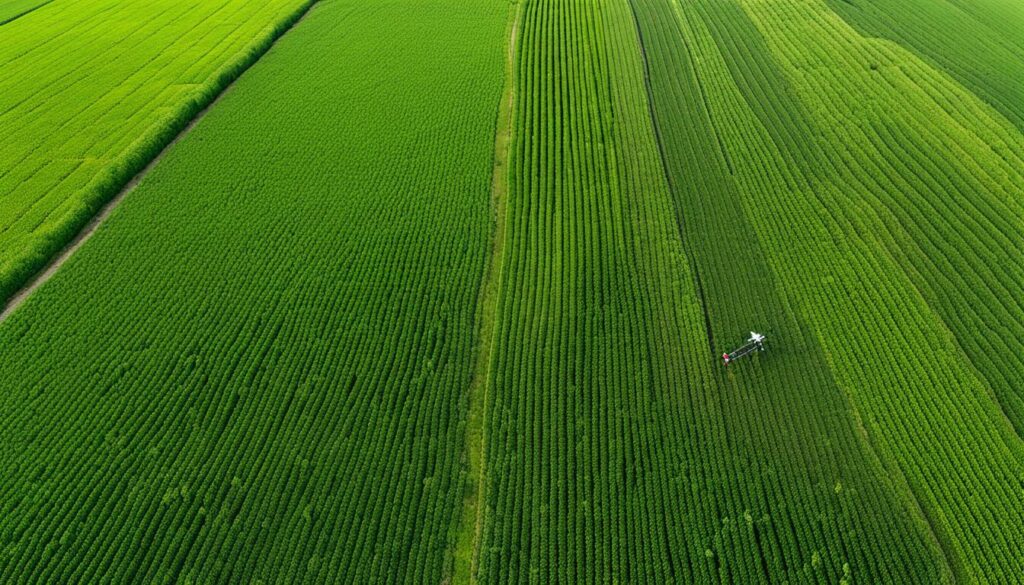
One of the key benefits of using drones for crop monitoring is their ability to detect plant diseases. Drones can capture high-resolution images and use image analysis algorithms to identify signs of disease such as discoloration or abnormal growth patterns. This early detection allows farmers to take immediate action, preventing the spread of diseases and minimizing crop damage. Additionally, drones can monitor crops on a regular basis, providing real-time data on their health and growth, helping farmers make timely decisions.
Another advantage of drone technology is its precision in crop monitoring. Drones can fly at low altitudes and capture highly detailed images, allowing farmers to monitor crop conditions at a micro-level. This level of precision enables targeted interventions, such as applying pesticides or fertilizers only where needed, minimizing chemical usage and reducing environmental impact. By optimizing crop health and quality, drones contribute to increased yield and improved overall farming efficiency.
Benefits of Drone Technology for Crop Monitoring:
- Early detection of plant diseases
- Real-time monitoring of crop health and growth
- Precision application of pesticides and fertilizers
- Targeted interventions based on detailed crop analysis
- Increased yield and improved farming efficiency
In conclusion, drone technology offers significant benefits for crop monitoring and optimizing crop health and quality. With their advanced sensor technology and precision capabilities, drones provide farmers with valuable data for informed decision-making. By detecting plant diseases early, providing real-time monitoring, and enabling targeted interventions, drones contribute to higher yields, reduced environmental impact, and improved overall farming efficiency.
Increase Efficiency and Productivity with Drone Technology
Drones in agriculture have revolutionized the way farmers manage their land and crops. These unmanned aerial vehicles (UAVs) provide valuable data and imagery that can enhance efficiency and productivity on the farm. From aerial photography to remote sensing technology, drones offer a range of tools to optimize farm management and planning.
Drone Data for Farm Management
One of the key benefits of using drones in agriculture is the collection of vast amounts of data. Drones equipped with high-resolution cameras and sensors can capture detailed images and measurements of crops, livestock, and land. This data can be used to create accurate maps for farm planning and resource allocation. By analyzing the drone data, farmers can identify areas that require attention, such as irrigation, fertilization, or pest control. They can also monitor crop health and detect any potential issues before they spread, saving time and resources.

Aerial Photography in Agriculture
Aerial photography is a powerful tool that drones bring to the agricultural industry. Through the use of high-quality cameras mounted on drones, farmers can capture detailed images of their fields from above. These images provide a bird’s-eye view of the entire farm, allowing farmers to identify any irregularities or inconsistencies. By comparing images taken over time, farmers can track changes in crop growth, monitor field conditions, and evaluate the effectiveness of their farming practices. Aerial photography also enables farmers to detect and address issues such as erosion, drainage problems, or weed infestations in a timely manner.
Unmanned Aerial Vehicles in Agriculture
Unmanned aerial vehicles, or UAVs, have become an indispensable tool for farmers. These drones can be equipped with various sensors, including thermal cameras and infrared sensors, which provide valuable information about crop health and water stress. Farmers can use this data to make informed decisions about irrigation schedules, nutrient application, and pest control. With the ability to cover large areas quickly and efficiently, UAVs save farmers time and labor. They can also access hard-to-reach areas, such as hilly terrain or densely planted fields, which would be challenging for humans to navigate.
Remote Sensing Technology
Remote sensing technology is another valuable application of drones in agriculture. By using specialized sensors and cameras, drones can capture data that is invisible to the naked eye, such as infrared radiation or soil moisture levels. This data can be used to create detailed maps of the farm, identifying variations in soil health or crop growth. Armed with this information, farmers can develop targeted strategies to address specific areas of concern, ultimately maximizing crop yields and reducing waste. Remote sensing technology also helps farmers monitor the impact of environmental factors, such as weather patterns or climate change, on their crops.
| Benefits of Drone Technology in Farm Management | Benefits of Drone Technology in Crop Monitoring |
|---|---|
| Accurate farm mapping and planning | Early detection of plant diseases and pests |
| Efficient resource allocation | Real-time monitoring of crop health |
| Time and labor savings | Identifying areas for targeted fertilization |
| Improved decision-making | Optimizing irrigation schedules |
As the use of drones in agriculture continues to evolve, farmers are discovering new ways to increase efficiency and productivity on their farms. By harnessing the power of drone technology, farmers can gather precise data, monitor crop health, and make informed decisions about farm management and planning. Aerial photography, unmanned aerial vehicles, and remote sensing technology are just a few of the tools that drones bring to the agricultural industry. With the future of farming becoming increasingly technology-driven, drones are playing a vital role in shaping the modern agricultural landscape.
Section 5: Improve Environmental Sustainability with Drone Technology
Drones play a crucial role in promoting sustainable agriculture and reducing the environmental impact of farming practices. With their advanced capabilities, drones enable precision farming techniques that optimize resource usage and minimize chemical runoff.
One of the key benefits of using drones in agriculture is the ability to apply pesticides and fertilizers more efficiently. With precise application technology, drones can target specific areas that require treatment, reducing the overall amount of chemicals used. This not only minimizes the risk of environmental contamination but also saves costs for farmers.
Furthermore, drones contribute to efficient irrigation management, ensuring optimal water usage. By gathering data on soil moisture levels and crop health, drones help farmers make informed decisions about irrigation. This prevents overwatering and reduces water waste, conserving one of our most valuable resources.
| Drones in Agriculture: | Benefits: |
|---|---|
| Efficient pesticide application | Reduces chemical runoff and minimizes environmental contamination |
| Optimized fertilizer usage | Minimizes excess chemical application and saves costs |
| Precise irrigation management | Conserves water resources and prevents overwatering |
Moreover, drones enable aerial crop analysis, which helps identify pest infestations and diseases at an early stage. By detecting these issues early on, farmers can take targeted action, reducing the need for widespread pesticide use and minimizing the impact on beneficial insects.
In conclusion, drones offer significant advantages for promoting sustainable agriculture and reducing the environmental impact of farming. Through precise pesticide and fertilizer application, efficient irrigation management, and early pest detection, drones help farmers optimize resource usage and protect our ecosystems.
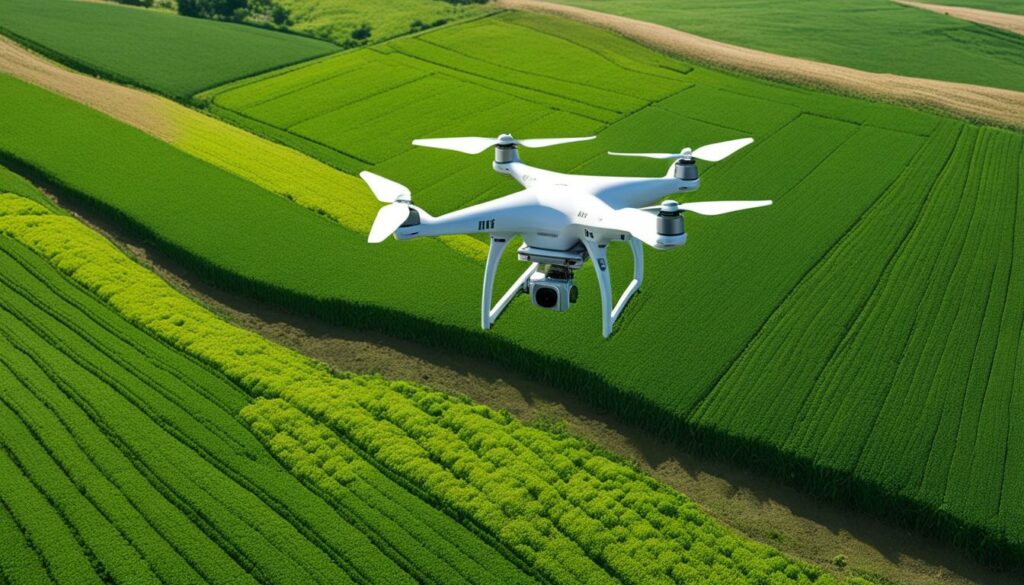
Section 6: Increase Safety and Reduce Risks in Agribusiness with Drones
Drones have revolutionized the agricultural industry by significantly improving safety and reducing risks in various aspects of agribusiness. By leveraging drone technology, farmers can now enhance their operations while ensuring the safety and well-being of their workers, livestock, and overall farm environment.
One of the key advantages of using agricultural drones is their ability to assess and monitor areas in a safe and efficient manner. After storms or natural disasters, drones can be deployed to quickly assess the extent of damage, helping farmers avoid potential risks to human workers. This not only speeds up the claim process but also ensures the safety of personnel by minimizing exposure to hazardous conditions.
Drones also play a crucial role in livestock farming by enabling farmers to monitor animal behavior, detect injuries or illnesses, and track their movement across the farm. With drones equipped with thermal imaging capabilities, potential hazards or abnormalities can be identified, further enhancing overall farm safety and reducing the risk of livestock accidents.
With the use of agricultural drones, farmers can proactively identify and manage risks associated with their operations, promoting a safer and more secure working environment. The ability to remotely monitor and assess the farm from aerial perspectives allows for early detection of potential hazards, such as land erosion, equipment malfunctions, or pest infestations. By addressing these risks promptly, farmers can mitigate potential damages and ensure a more resilient and sustainable agribusiness.

Key Benefits:
- Improved safety for workers and livestock
- Rapid assessment of post-disaster situations
- Early detection and mitigation of potential hazards
- Enhanced monitoring and tracking of livestock
“Drones have become a game-changer in the agricultural industry, significantly improving safety measures and reducing risks in various aspects of farming.”
Section 7: Reduce Costs and Save Resources with Drones in Agriculture
One of the significant benefits of using drones in agriculture is the potential for cost savings and resource optimization. Drones equipped with advanced technology and imaging capabilities can help farmers streamline their operations, reduce labor costs, and improve overall efficiency.
Efficient irrigation management is a crucial aspect of farming, and drones play a vital role in optimizing water usage. By capturing high-resolution imagery and analyzing crop health and soil moisture levels, drones enable farmers to determine precise irrigation needs. This not only reduces water waste but also lowers water and energy costs, resulting in significant savings.
Furthermore, drones assist in reducing labor costs by automating various tasks that would otherwise require manual labor. For instance, drones can be used to monitor crops, apply pesticides or fertilizers, and even assess livestock movements. By eliminating the need for manual labor in these areas, farmers can allocate resources more efficiently and reduce labor expenses.
| Benefits of Drones for Cost Savings | Benefits of Drones for Resource Optimization |
|---|---|
| – Reduced labor costs | – Efficient irrigation management |
| – Precision application of pesticides and fertilizers | – Streamlined resource allocation |
| – Time-saving technology | – Improved overall efficiency |
In summary, drones in agriculture offer significant cost savings and resource optimization opportunities. By improving irrigation management, reducing labor costs, and streamlining resource allocation, drones help farmers operate more efficiently and sustainably. As farmers continue to embrace this technology, the financial and environmental benefits of using drones in agriculture will become even more pronounced.
Future Potential and the Growing Importance of Drone Technology in Agriculture
Drone technology continues to revolutionize the agriculture industry, offering innovative solutions to age-old challenges. As we look to the future, it is clear that drones will play an increasingly important role in modern farming practices. From enhancing crop quality to reducing costs and promoting environmental sustainability, the possibilities are endless.
One of the key trends in drone technology is the advancement of precision farming. Drones equipped with advanced sensors and imaging capabilities can gather precise data on crop health, soil moisture, and nutrient levels. This information enables farmers to make informed decisions about irrigation, fertilization, and pest control, ultimately optimizing crop health and increasing yields.
Another exciting development is the evolving uses of drones in farming. Researchers are exploring new applications such as pollination and AI-based monitoring systems. Imagine a future where drones can autonomously pollinate crops, ensuring their reproductive success. This would be a game-changer for industries heavily reliant on pollinators.
Additionally, drones are proving invaluable in disaster assessment and risk reduction. After storms or natural disasters, drones can quickly assess the damage to crops, infrastructure, and livestock, providing real-time data to speed up the claims process and minimize risks to human workers. This technology enhances both safety and efficiency in the agribusiness sector.
Table: Advancements in Drone Technology
| Advancement | Description |
|---|---|
| Enhanced Imaging and Sensing | Drones equipped with high-resolution cameras and advanced sensors provide detailed data on crop health, soil conditions, and irrigation needs. |
| Precision Application Technology | Drones deliver precise application of pesticides, fertilizers, and other inputs, reducing waste and minimizing environmental impact. |
| Autonomous Functionality | Advancements in AI and machine learning enable drones to operate autonomously, improving efficiency and reducing the need for manual intervention. |
| Improved Battery Life | Longer flight times and quick battery swap capabilities enable drones to cover larger areas and collect more data in a single flight. |
As drone technology continues to evolve, the agriculture industry must adapt to leverage its full potential. Farmers and agribusinesses that embrace drone technology will gain a competitive advantage, benefiting from increased efficiency, reduced costs, and improved sustainability. The future of farming lies in the skies, with drones leading the way to a more productive and sustainable agricultural landscape.
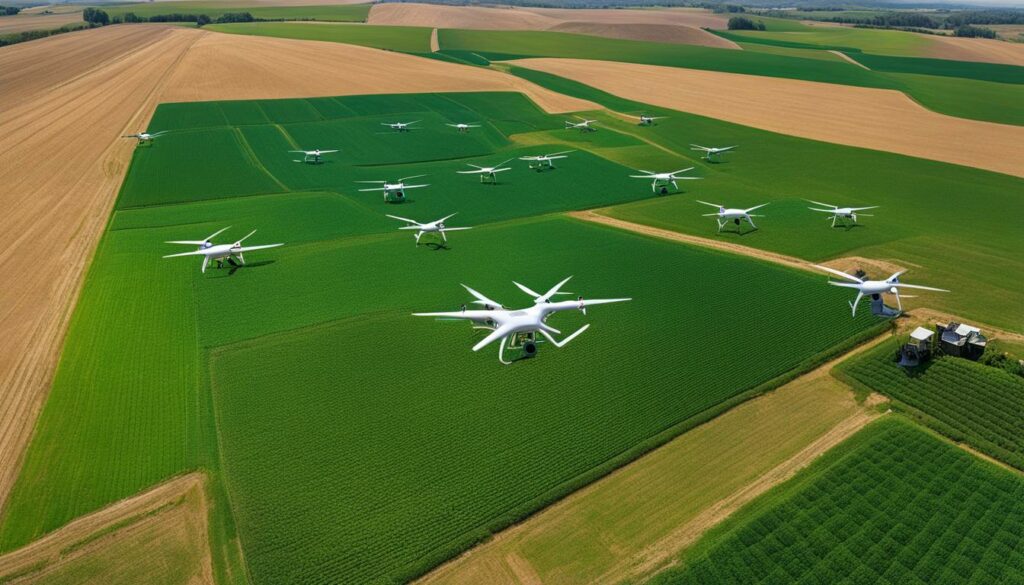
Disclaimer: The image used in this article is for illustrative purposes only and does not represent specific drone technology in agriculture.
Conclusion: The Impressive Benefits of Using Drones in Agriculture
In summary, the use of drones in agriculture offers a multitude of benefits and has revolutionized modern farming practices. Drones have proven to be invaluable tools for farmers, providing enhanced crop monitoring, improved efficiency, and increased productivity.
With advanced sensor technology and high-resolution imagery, drones enable farmers to optimize crop health and quality. By collecting accurate data on crop growth, health, and soil moisture, farmers can make informed decisions regarding irrigation, fertilization, and pest control. Drones also play a crucial role in identifying and mitigating plant diseases and pests, minimizing crop damage and ensuring healthier yields.
Furthermore, drones contribute to efficient farm management and planning by offering valuable data on land mapping, livestock monitoring, and animal behavior. Aerial photography and remote sensing technology assist farmers in identifying boundaries, drainage patterns, and potential problem areas, leading to more effective resource allocation and decision-making.
The environmental sustainability of agriculture is also greatly improved with the use of drones. With precise application technology, drones can apply pesticides and fertilizers only where needed, reducing chemical runoff and drift. This leads to a reduced negative impact on nearby crops and soil, as well as decreased air pollution. Drones also allow for spot treatments and targeted crop surveillance, minimizing waste and optimizing resource allocation.
In conclusion, the benefits of using drones in agriculture are vast and varied. From increasing efficiency and productivity to optimizing crop health and quality, drones play a significant role in modern farming practices. They enhance farm management, reduce costs, and promote environmental sustainability. As technology continues to advance, the importance and applications of drone technology in agriculture will only continue to grow, shaping the future of farming.
FAQ
What are the benefits of using drones in agriculture?
Drones in agriculture offer real-time monitoring, high-resolution imagery, and data gathering capabilities, saving time and increasing efficiency for farmers. They provide detailed information on crop and livestock conditions, land topography, soil and irrigation, and also aid in collecting soil and water samples.
How do drones increase efficiency and productivity in farming?
By providing real-time, high-definition images and data, drones enable farmers to quickly identify potential issues in crops or livestock and take prompt action. They also assist in troubleshooting by monitoring critical areas and detecting leaks or damage, helping farmers make informed decisions and improve overall productivity.
How do drones optimize crop health and quality?
Drones equipped with advanced sensor technology provide detailed and accurate information on crop growth, health, and soil moisture. This enables farmers to make informed decisions regarding irrigation, fertilization, and pest control. Drones can also detect plant diseases and pests, allowing for immediate action to prevent crop damage and ensure better overall crop health.
How can drones enhance farm management and planning?
Aerial photography and remote sensing technology enable farmers to monitor and map their land, identify boundaries, drainage patterns, and potential problem areas. This data is used for improved farm planning, resource allocation, and decision-making. Drones also gather data on livestock movement, count, and behavior, aiding in efficient farm management.
How do drones contribute to environmental sustainability in agriculture?
Drones reduce the environmental impact by applying pesticides and fertilizers only where needed, minimizing chemical runoff and drift. They also offer spot treatments and targeted crop surveillance, allowing for more efficient resource allocation and waste reduction.
How do drones improve safety in agribusiness?
Drones reduce the need for manual labor in potentially dangerous areas and can assess and monitor areas after storms or disasters, avoiding risks to human workers. In livestock farming, drones monitor animal behavior, detect injuries or illnesses, and track their movement, ensuring safety and well-being. Drones equipped with thermal imaging can also detect potential hazards or abnormalities, improving overall farm safety.
How do drones help reduce costs in agriculture?
Drones optimize resources by improving irrigation management, reducing water and energy costs. They also reduce the need for manual spraying and fertilization, saving on labor costs and chemical usage, resulting in overall cost savings and resource optimization.
What is the future potential of drone technology in agriculture?
The market for agricultural drones is expected to grow significantly, driven by the increasing demand for precision farming and efficient resource management. Researchers are exploring new uses for drones, such as pollination and AI-based monitoring systems, indicating a promising future for drone technology in agriculture.
What are the benefits and applications of drone technology in modern agriculture?
Drones provide numerous benefits, including enhanced crop quality, time-saving efficiency, improved farm management and planning, environmental sustainability, increased safety, and reduced costs. They have applications in monitoring crops and livestock, mapping land, collecting data, and optimizing resource allocation in modern agriculture.


